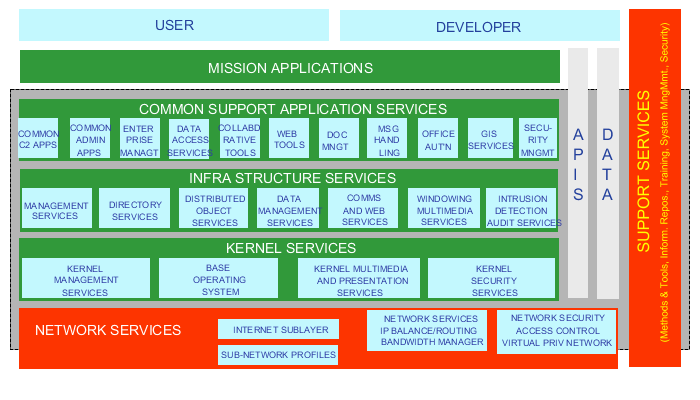A.2. Platform Oriented Environment
9. Volume 1, Appendix C of the NISP describes the NATO Technical Reference Model (NTRM) and NATO Common Operating Environment (NCOE) Component Model (NCM). These models can be used in describing services in a platform oriented environment.
A.2.1. NTRM
10. As stated in Volume 1, Annex E of the NISP, the NTRM focuses on separating data from applications and applications from the computing platform. The NTRM provides the definitions necessary for designing and defining architectures and related service components. It also identifies service areas (i.e., capabilities that have been grouped together by functions - see Figure A.2), as well as their interfaces.

Figure A.2. NTRM Service View
11. The Application Platform Entity is structured in the following 12 Application Platform Service Areas:
-
User Interface Services. These services define how users may interact with an application. The term user interface in this context means a graphical user interface (GUI). Standards are not only required for setting up and managing graphical windows, but also for the toolkit and generic 'look and feel'.
-
Data Management Services. The management of data is central to most systems. To improve interoperability, data should be defined independently from the processes that create or use it, and should be maintained and shared among many processes.
-
Data Interchange Services. These services provide support for the interchange of data between applications. They are designed to handle data interchange between applications on the same or on heterogeneous platforms.
-
Graphics Services. These services provide functions required for creating and manipulating graphics.
-
Communication Services. These services provide distributed applications support for data access and applications interoperability in heterogeneous or homogeneous networked environments.
-
Operating System Services. These services are the core services needed to operate and administer the application platform and provide an interface between applications software and platform. Application programmers will use operating system services to obtain operating system functionality.
-
Internationalization Services. Within the context of the NTRM, internationalization provides a set of services and interfaces that allow a user to define, select, and switch between different culturally related application environments supported by the particular implementation. Character sets and data representation services include the capability to input, store, manipulate, retrieve, communicate, and present data independently of the coding scheme used. This includes the capability to maintain and access a central character set repository of all coded character sets used throughout the platform.
-
System Management Services. Information systems are composed of a wide variety of diverse resources that must be managed effectively to achieve the goals of an open system environment. While the individual resources (such as printers, software, users, processors) may differ widely, the abstraction of these resources as managed objects allows for their treatment in a uniform manner.
-
Security Services. Different groups of individuals within and across the various NATO applications need to work with specific sets of data elements. Access to these sets of data elements is to be restricted to authorized users. Satisfaction of this requirement has traditionally been accomplished by the implementation of separate information systems. Organizations cannot continue to afford to implement separate information systems to satisfy this requirement, nor is it effective to require the user to change interface components every time the need arises to operate with a different restricted data set. Significant benefit will accrue when an individual information system can effectively support the needs of different groups of users and data sets.
-
Distributed Computing Services. These services provide specialized support for applications that may be physically or logically dispersed among computer systems in a network, but yet wish to maintain a co-operative processing environment. The classical definition of a computer becomes blurred as the processes that contribute to information processing become distributed across a facility or a network. As with other cross-cutting services, the requisite components of distributed computing services typically exist within particular service areas.
-
Software Engineering Services. The procedural aspect of an application is embodied in the programming languages used to code it. Additionally, professional system developers require methods and tools appropriate to the development and maintenance of applications.
-
Common C2 Applications Services. These services provide the ability to view data (i.e., share) in a common way across the network. Common C2 Applications Services promote interoperability among diverse functional mission area domains and may be executed between both individual and multiple functional application domain areas.
12. In the NC3TA each of these service areas was further defined into one or more functional classes, with each class mapped to one or more standards. For example, communication services has a class called messaging with Simple Mail Transfer Protocol (SMTP) being one of the protocols used to support the communication service.
A.2.2. NCM
13. The NTRM provides the structural basis for defining the NCOE (NATO Common Operating Environment) Component Model (NCM). The NCOE provides the set of building blocks and guidance necessary for effective maintenance of open system design, development, implementation and integration. The NCM is shown below in Figure A.3.

Figure A.3. NCOE Component Model
14. The principal components of the NCM include:
-
Network Services. The NCOE Network Services constitute the basic interface between the platform and the underlying networking infrastructure and include the Internet sub-layer services.
-
Kernel Services. The Kernel Services are that subset of the NCOE component segments, which are required for all compliant platforms. At a minimum, this sub-set would consist of the operating system, windowing software, security services, segment installation software and an executive manager.
-
Infrastructure Services. Infrastructure services are those services that directly support the flow of information across NATO systems. Infrastructure services provide a set of integrated capabilities that the applications will access to invoke NCOE services.
-
Common Support Application Services. Common Support Application Services provide services to process and view data in a common way (share data) across the network. The NCOE common support application services promote interoperability among various Mission Applications.
-
Application Programming Interfaces. Applications are integrated into the NCOE through a common set of Application Programming Interfaces (APIs). The APIs are invoked by the applications and services as required.
-
Data Component Definition. The data component refers to the way in which data is taken into account in the NCOE and is related to the main components of the NCOE (Common Support Application Services, Infrastructure Services, Kernel Services) and even, out of NCOE components, in the strictest sense, to Mission Applications.
-
Support Services. The NCOE Support Services include Methods and Tools, Information Repository, Training Services, System Management and Security.
A.2.3. OSI Protocol Stack and Services
15. The OSI protocol stack (as well as the Internet stack) is based on the concept of layering as depicted below (Figure A.4):

Figure A.4. Service Layering
16. A key aspect of the layer principle is layer independence. The service user is not concerned with the specifics of the protocol used by the service provider to provide the service. The user of the N Layer service uses defined service primitives to use the services provided by the N Layer. The N Layer uses the N Layer protocol and services provided by the N-1 Layer to provide the N Layer services. The N Layer protocol definition describes the rules which each N Layer service peer uses when communicating with its other service peers. As long as there are no changes to the service interface, the service user at that layer is completely unaffected by changes in the underlying layers or by the protocol used within the layer. Protocol layering is key to the development the profiles contained in the NISP.